Kwang In Kim
Subspace-based Approximate Hessian Method for Zeroth-Order Optimization
Jul 08, 2025Abstract:Zeroth-order optimization addresses problems where gradient information is inaccessible or impractical to compute. While most existing methods rely on first-order approximations, incorporating second-order (curvature) information can, in principle, significantly accelerate convergence. However, the high cost of function evaluations required to estimate Hessian matrices often limits practical applicability. We present the subspace-based approximate Hessian (ZO-SAH) method, a zeroth-order optimization algorithm that mitigates these costs by focusing on randomly selected two-dimensional subspaces. Within each subspace, ZO-SAH estimates the Hessian by fitting a quadratic polynomial to the objective function and extracting its second-order coefficients. To further reduce function-query costs, ZO-SAH employs a periodic subspace-switching strategy that reuses function evaluations across optimization steps. Experiments on eight benchmark datasets, including logistic regression and deep neural network training tasks, demonstrate that ZO-SAH achieves significantly faster convergence than existing zeroth-order methods.
PoseBH: Prototypical Multi-Dataset Training Beyond Human Pose Estimation
May 23, 2025Abstract:We study multi-dataset training (MDT) for pose estimation, where skeletal heterogeneity presents a unique challenge that existing methods have yet to address. In traditional domains, \eg regression and classification, MDT typically relies on dataset merging or multi-head supervision. However, the diversity of skeleton types and limited cross-dataset supervision complicate integration in pose estimation. To address these challenges, we introduce PoseBH, a new MDT framework that tackles keypoint heterogeneity and limited supervision through two key techniques. First, we propose nonparametric keypoint prototypes that learn within a unified embedding space, enabling seamless integration across skeleton types. Second, we develop a cross-type self-supervision mechanism that aligns keypoint predictions with keypoint embedding prototypes, providing supervision without relying on teacher-student models or additional augmentations. PoseBH substantially improves generalization across whole-body and animal pose datasets, including COCO-WholeBody, AP-10K, and APT-36K, while preserving performance on standard human pose benchmarks (COCO, MPII, and AIC). Furthermore, our learned keypoint embeddings transfer effectively to hand shape estimation (InterHand2.6M) and human body shape estimation (3DPW). The code for PoseBH is available at: https://github.com/uyoung-jeong/PoseBH.
GraspCorrect: Robotic Grasp Correction via Vision-Language Model-Guided Feedback
Mar 19, 2025Abstract:Despite significant advancements in robotic manipulation, achieving consistent and stable grasping remains a fundamental challenge, often limiting the successful execution of complex tasks. Our analysis reveals that even state-of-the-art policy models frequently exhibit unstable grasping behaviors, leading to failure cases that create bottlenecks in real-world robotic applications. To address these challenges, we introduce GraspCorrect, a plug-and-play module designed to enhance grasp performance through vision-language model-guided feedback. GraspCorrect employs an iterative visual question-answering framework with two key components: grasp-guided prompting, which incorporates task-specific constraints, and object-aware sampling, which ensures the selection of physically feasible grasp candidates. By iteratively generating intermediate visual goals and translating them into joint-level actions, GraspCorrect significantly improves grasp stability and consistently enhances task success rates across existing policy models in the RLBench and CALVIN datasets.
REP: Resource-Efficient Prompting for On-device Continual Learning
Jun 07, 2024



Abstract:On-device continual learning (CL) requires the co-optimization of model accuracy and resource efficiency to be practical. This is extremely challenging because it must preserve accuracy while learning new tasks with continuously drifting data and maintain both high energy and memory efficiency to be deployable on real-world devices. Typically, a CL method leverages one of two types of backbone networks: CNN or ViT. It is commonly believed that CNN-based CL excels in resource efficiency, whereas ViT-based CL is superior in model performance, making each option attractive only for a single aspect. In this paper, we revisit this comparison while embracing powerful pre-trained ViT models of various sizes, including ViT-Ti (5.8M parameters). Our detailed analysis reveals that many practical options exist today for making ViT-based methods more suitable for on-device CL, even when accuracy, energy, and memory are all considered. To further expand this impact, we introduce REP, which improves resource efficiency specifically targeting prompt-based rehearsal-free methods. Our key focus is on avoiding catastrophic trade-offs with accuracy while trimming computational and memory costs throughout the training process. We achieve this by exploiting swift prompt selection that enhances input data using a carefully provisioned model, and by developing two novel algorithms-adaptive token merging (AToM) and adaptive layer dropping (ALD)-that optimize the prompt updating stage. In particular, AToM and ALD perform selective skipping across the data and model-layer dimensions without compromising task-specific features in vision transformer models. Extensive experiments on three image classification datasets validate REP's superior resource efficiency over current state-of-the-art methods.
In Search of a Data Transformation That Accelerates Neural Field Training
Nov 28, 2023

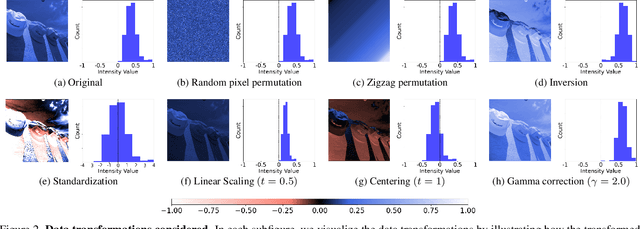
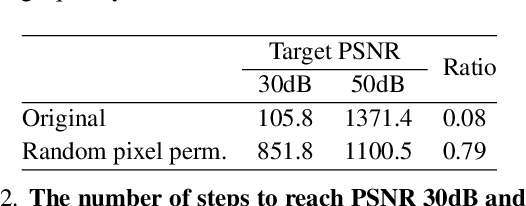
Abstract:Neural field is an emerging paradigm in data representation that trains a neural network to approximate the given signal. A key obstacle that prevents its widespread adoption is the encoding speed-generating neural fields requires an overfitting of a neural network, which can take a significant number of SGD steps to reach the desired fidelity level. In this paper, we delve into the impacts of data transformations on the speed of neural field training, specifically focusing on how permuting pixel locations affect the convergence speed of SGD. Counterintuitively, we find that randomly permuting the pixel locations can considerably accelerate the training. To explain this phenomenon, we examine the neural field training through the lens of PSNR curves, loss landscapes, and error patterns. Our analyses suggest that the random pixel permutations remove the easy-to-fit patterns, which facilitate easy optimization in the early stage but hinder capturing fine details of the signal.
BoIR: Box-Supervised Instance Representation for Multi-Person Pose Estimation
Sep 25, 2023



Abstract:Single-stage multi-person human pose estimation (MPPE) methods have shown great performance improvements, but existing methods fail to disentangle features by individual instances under crowded scenes. In this paper, we propose a bounding box-level instance representation learning called BoIR, which simultaneously solves instance detection, instance disentanglement, and instance-keypoint association problems. Our new instance embedding loss provides a learning signal on the entire area of the image with bounding box annotations, achieving globally consistent and disentangled instance representation. Our method exploits multi-task learning of bottom-up keypoint estimation, bounding box regression, and contrastive instance embedding learning, without additional computational cost during inference. BoIR is effective for crowded scenes, outperforming state-of-the-art on COCO val (0.8 AP), COCO test-dev (0.5 AP), CrowdPose (4.9 AP), and OCHuman (3.5 AP). Code will be available at https://github.com/uyoung-jeong/BoIR
Active Deep Learning Guided by Efficient Gaussian Process Surrogates
Jan 07, 2023



Abstract:The success of active learning relies on the exploration of the underlying data-generating distributions, populating sparsely labeled data areas, and exploitation of the information about the task gained by the baseline (neural network) learners. In this paper, we present a new algorithm that combines these two active learning modes. Our algorithm adopts a Bayesian surrogate for the baseline learner, and it optimizes the exploration process by maximizing the gain of information caused by new labels. Further, by instantly updating the surrogate learner for each new data instance, our model can faithfully simulate and exploit the continuous learning behavior of the learner without having to actually retrain it per label. In experiments with four benchmark classification datasets, our method demonstrated significant performance gain over state-of-the-arts.
S$^2$Contact: Graph-based Network for 3D Hand-Object Contact Estimation with Semi-Supervised Learning
Aug 01, 2022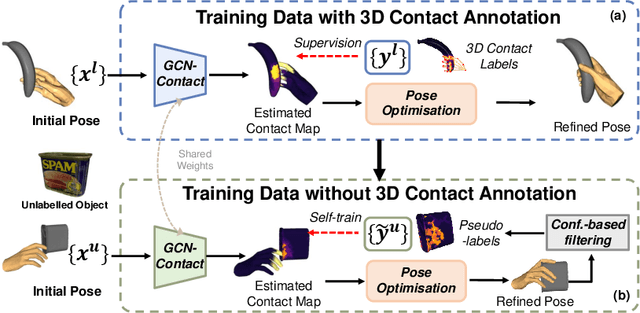

Abstract:Despite the recent efforts in accurate 3D annotations in hand and object datasets, there still exist gaps in 3D hand and object reconstructions. Existing works leverage contact maps to refine inaccurate hand-object pose estimations and generate grasps given object models. However, they require explicit 3D supervision which is seldom available and therefore, are limited to constrained settings, e.g., where thermal cameras observe residual heat left on manipulated objects. In this paper, we propose a novel semi-supervised framework that allows us to learn contact from monocular images. Specifically, we leverage visual and geometric consistency constraints in large-scale datasets for generating pseudo-labels in semi-supervised learning and propose an efficient graph-based network to infer contact. Our semi-supervised learning framework achieves a favourable improvement over the existing supervised learning methods trained on data with `limited' annotations. Notably, our proposed model is able to achieve superior results with less than half the network parameters and memory access cost when compared with the commonly-used PointNet-based approach. We show benefits from using a contact map that rules hand-object interactions to produce more accurate reconstructions. We further demonstrate that training with pseudo-labels can extend contact map estimations to out-of-domain objects and generalise better across multiple datasets.
Collaborative Learning for Hand and Object Reconstruction with Attention-guided Graph Convolution
Apr 27, 2022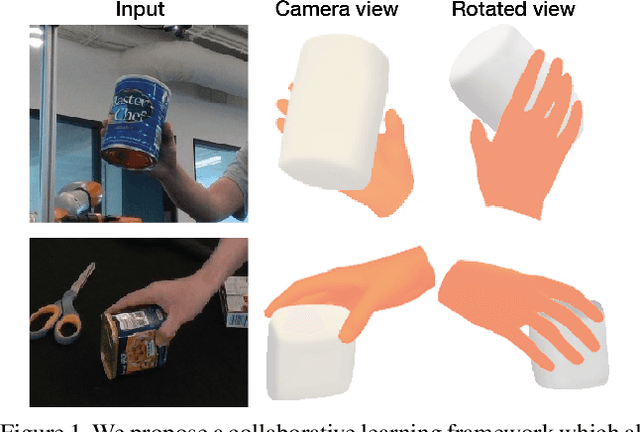

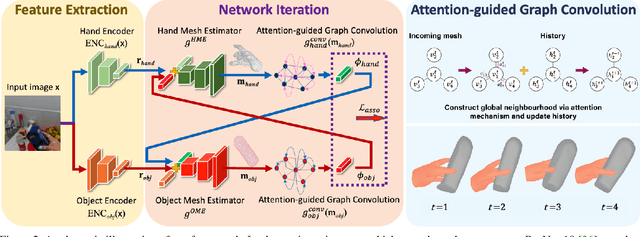
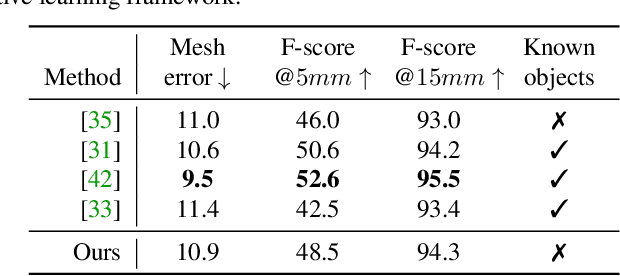
Abstract:Estimating the pose and shape of hands and objects under interaction finds numerous applications including augmented and virtual reality. Existing approaches for hand and object reconstruction require explicitly defined physical constraints and known objects, which limits its application domains. Our algorithm is agnostic to object models, and it learns the physical rules governing hand-object interaction. This requires automatically inferring the shapes and physical interaction of hands and (potentially unknown) objects. We seek to approach this challenging problem by proposing a collaborative learning strategy where two-branches of deep networks are learning from each other. Specifically, we transfer hand mesh information to the object branch and vice versa for the hand branch. The resulting optimisation (training) problem can be unstable, and we address this via two strategies: (i) attention-guided graph convolution which helps identify and focus on mutual occlusion and (ii) unsupervised associative loss which facilitates the transfer of information between the branches. Experiments using four widely-used benchmarks show that our framework achieves beyond state-of-the-art accuracy in 3D pose estimation, as well as recovers dense 3D hand and object shapes. Each technical component above contributes meaningfully in the ablation study.
Testing using Privileged Information by Adapting Features with Statistical Dependence
Nov 04, 2021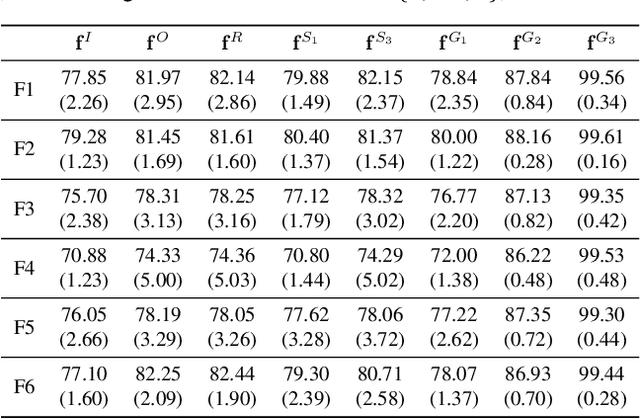
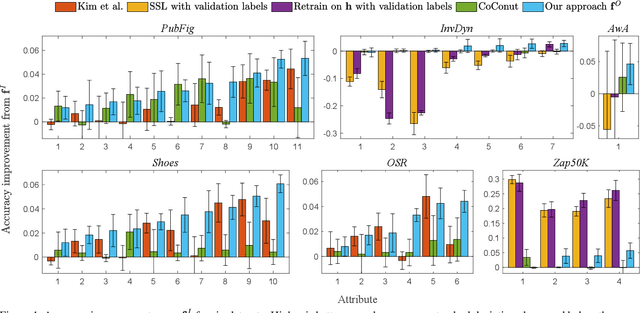

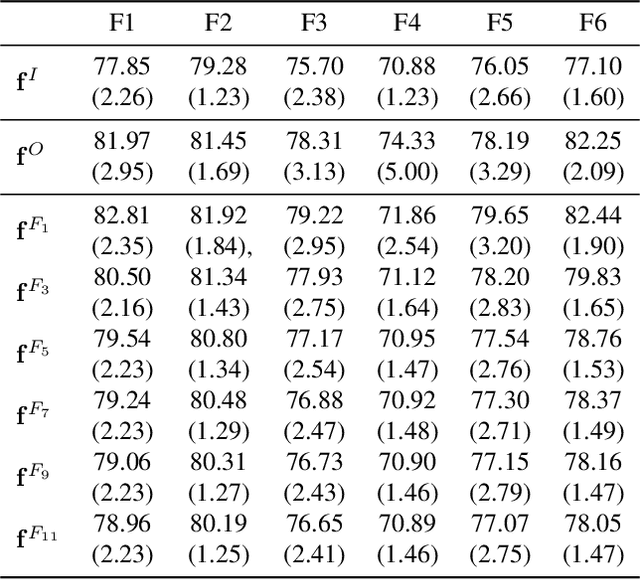
Abstract:Given an imperfect predictor, we exploit additional features at test time to improve the predictions made, without retraining and without knowledge of the prediction function. This scenario arises if training labels or data are proprietary, restricted, or no longer available, or if training itself is prohibitively expensive. We assume that the additional features are useful if they exhibit strong statistical dependence to the underlying perfect predictor. Then, we empirically estimate and strengthen the statistical dependence between the initial noisy predictor and the additional features via manifold denoising. As an example, we show that this approach leads to improvement in real-world visual attribute ranking. Project webpage: http://www.jamestompkin.com/tupi
 Add to Chrome
Add to Chrome Add to Firefox
Add to Firefox Add to Edge
Add to Edge